Authentic Injera (Ethiopian Flatbread)
This post may contain affiliate links. See my disclosure policy.
An authentic Injera recipe, the famous Ethiopian flatbread that’s so perfect for scooping up your favorite Ethiopian dishes and mopping up all of those flavorful juices and sauces. This recipe doesn’t take shortcuts but uses the traditional method for achieving the richest flavor. Whether you choose to use all teff or a combination of flour types, we’ll take you through the process step-by-step to ensure your success!
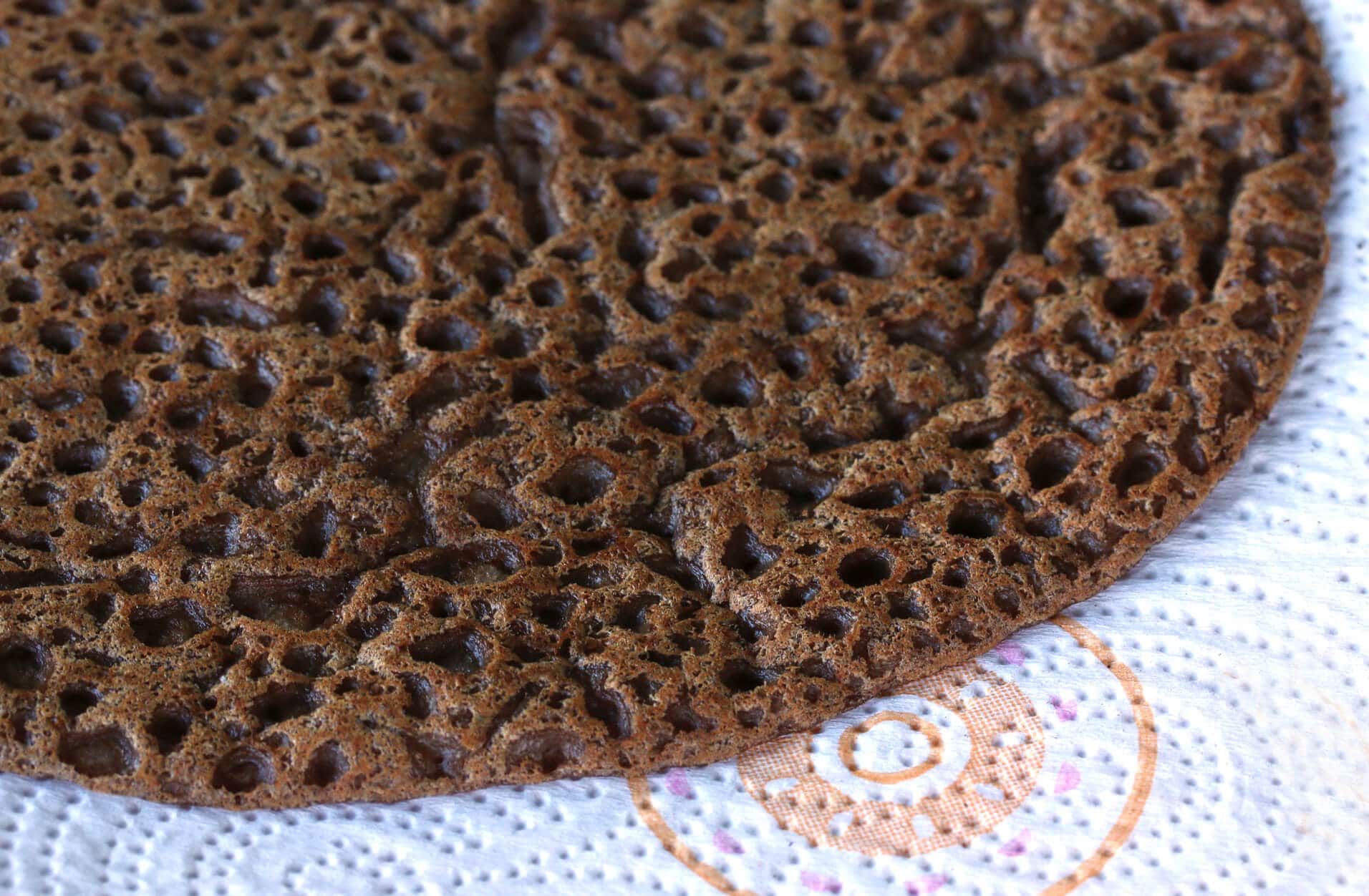
What is Injera?
If you’ve ever been to an Ethiopian restaurant – certainly if you’ve ever set foot in Ethiopia – you will have heard of injera. It’s a sourdough flatbread unlike any other sourdough. It starts out looking like a crepe but then develops a unique porous and slightly spongy texture. The thin batter is poured onto the cooking surface, traditionally a clay plate over a fire though now more commonly a specialized electric injera stove, and the bottom remains smooth while the top develops lots of pores which makes it ideal for scooping up stews and sauces.
And that’s exactly how injera is used, as an eating utensil. And as a plate. And often in place of the tablecloth. A variety of stews, vegetables and/or salads are placed on a large piece of injera and guests use their right hands to tear portions of the injera which are used for gripping the food. The porous texture of the injera makes it ideal for soaking up the juices.
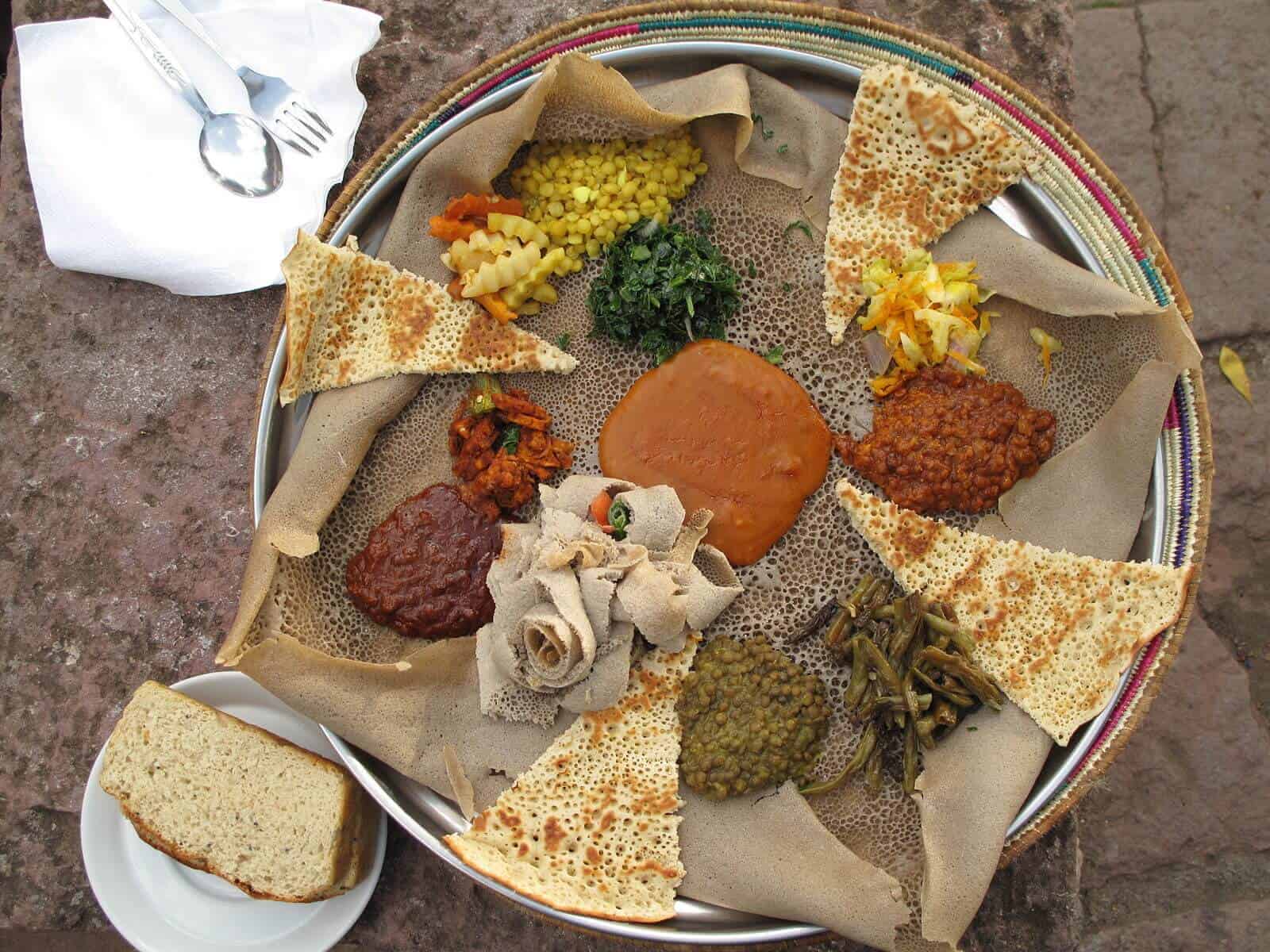
What is Teff?
Injera is traditionally made out of teff flour, the world’s tiniest grain and also one of the earliest domesticated plants having originated in Ethiopia and Eritrea (where injera is also widely consumed) between 4000 and 1000 BC. Its production is limited to only areas with adequate rainfall though so it’s relatively expensive for most African households. As such, many will replace some of the teff content with other flours like barley or wheat. For those who can afford it, injera made entirely of teff flour has the higher demand.
There are different varieties of teff ranging from white/ivory to red to dark brown. In Ethiopia white is generally preferred and will also produce a 100% teff injera that is a lighter in color than what is shown in the first photo and preparation photos. I’m using 100% dark teff flour which produces a very dark injera with a deeper flavor.
The challenge is that if you’re looking for a specific type of teff and like to grind your own grains, most manufacturers don’t differentiate the teff type on their package labeling. It’s mostly an aesthetic preference though and for most baking I do with teff it really doesn’t matter either way. With the injera it will make a difference in the color though if that’s an important factor to you. On Amazon you can purchase both Ivory Teff and Brown Teff.
Traditionally a clay plate, a mitad, placed over a fire is used for making injera. More commonly now specialized electric injera stoves are used. But unless you’re making injera constantly, a simple non-stick pan on the stovetop will do the job.
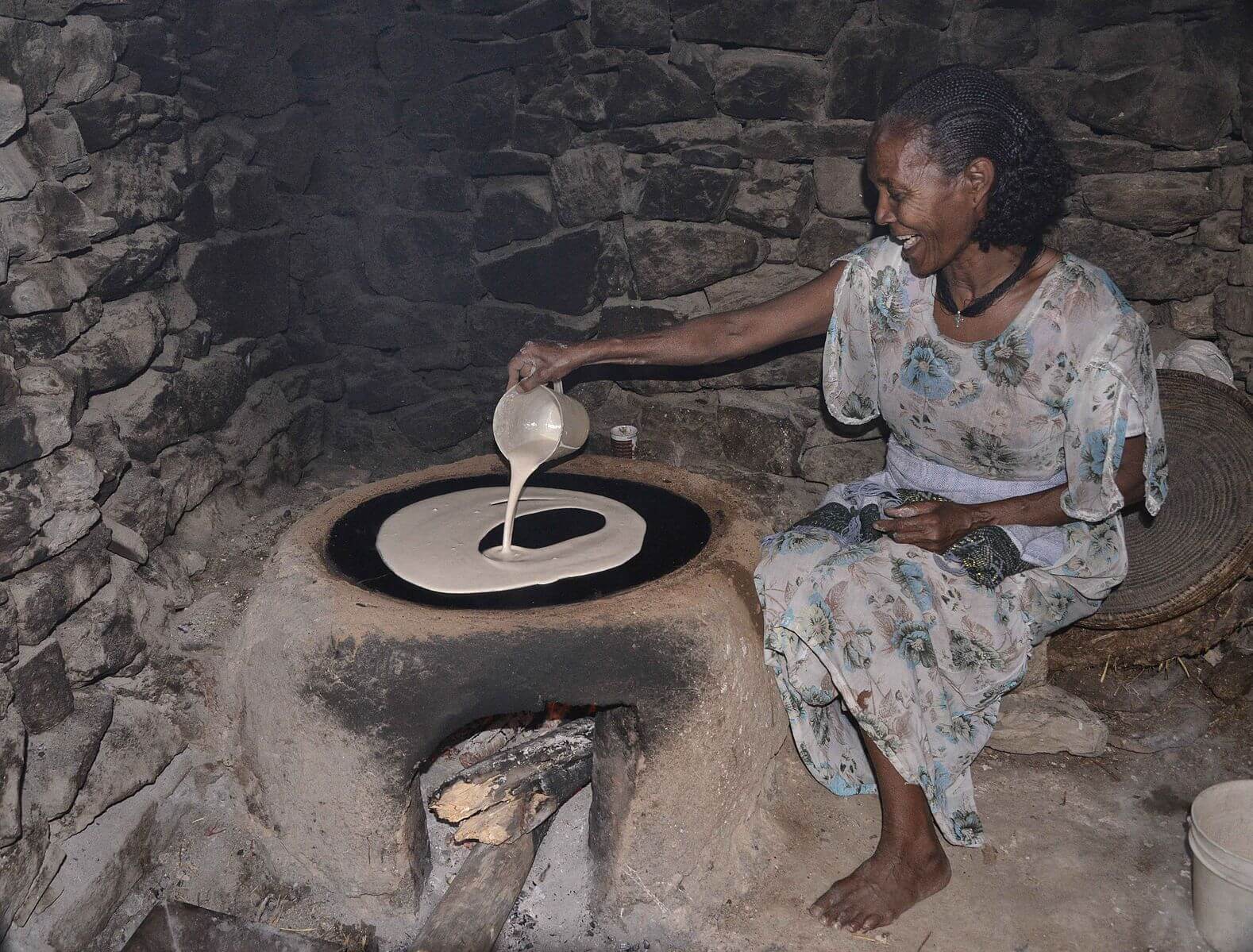
A special woven basket, called a mesab, in which the freshly made injera are placed.
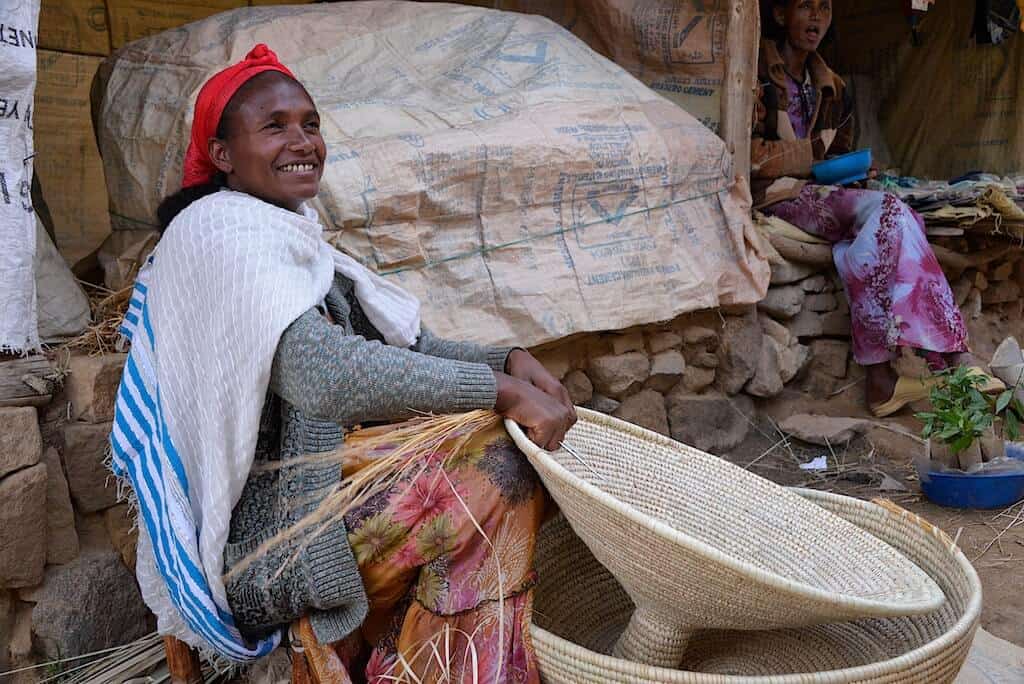
What to Serve With Injera
Injera is the traditional accompaniment to Doro Wat, Ethiopia’s famous spicy chicken stew, and together these constitute the national dish of Ethiopia. Injera is likewise commonly served with Sega Wat, the delicious beef version of Doro Wat as well as Misir Wat, a popular vegetarian dish made with red lentils. Injera is a great “neutral” and versatile side to serve with any of your favorite Ethiopian dishes.
Authentic Injera Recipe
Let’s get started!
And I don’t mean short-cut, one-day, cutting corners injera. I mean the real deal – authentic injera.
IMPORTANT NOTE before we begin: Both the texture and color of the injera will vary greatly depending on what kind of teff you use (dark or ivory) and whether or not you’re combining it with other flours. Gluten-based flours (e.g. wheat and barley) will yield a much different texture than 100% teff. In the pictures and recipe below I’m using 100% dark teff, something you will not find in restaurants and will look different than what most are accustomed to, but is traditional to Ethiopian home cooking.
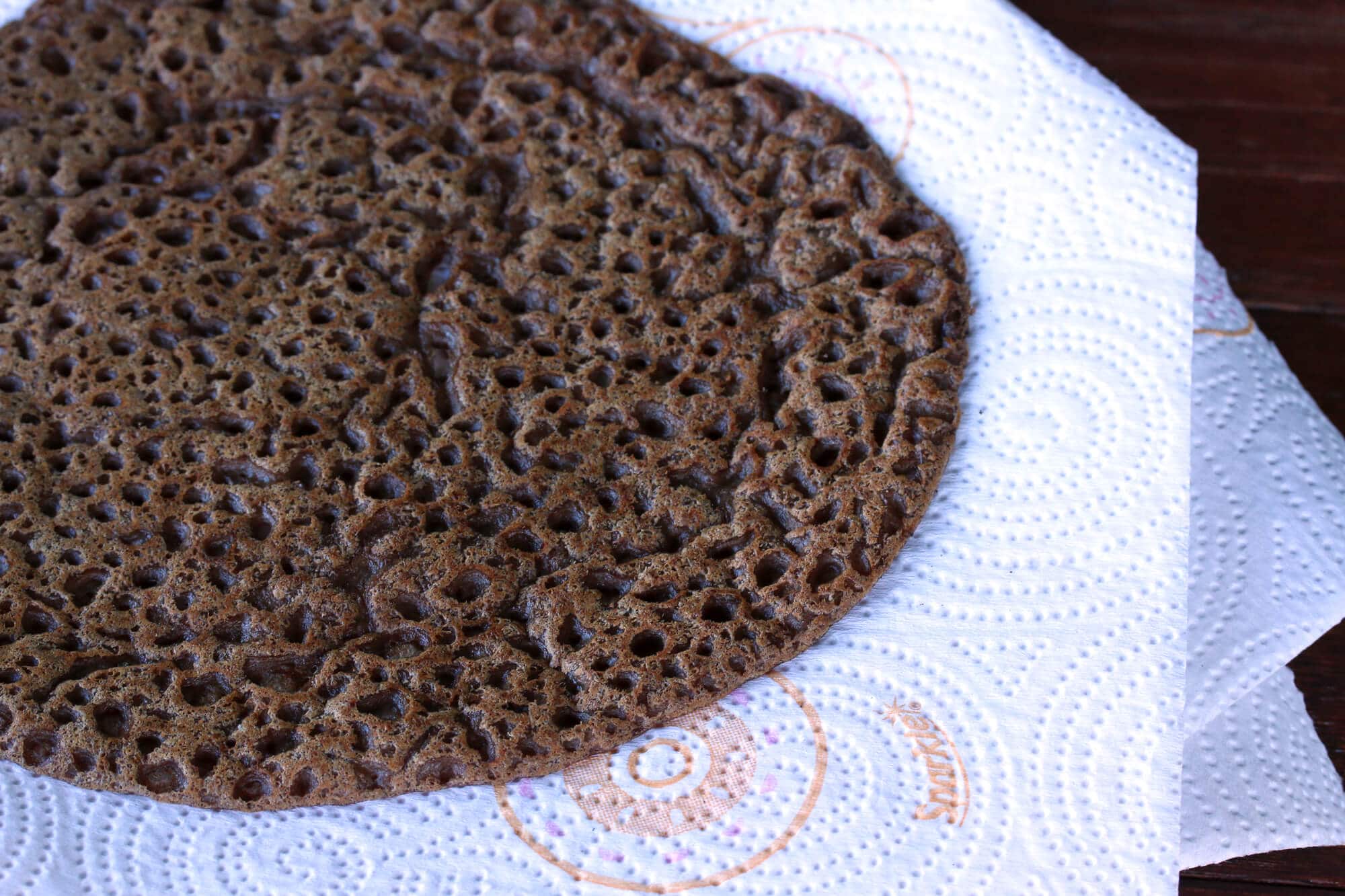
You can buy pre-ground teff flour or grind your own. I like to grind my own grains because 1) the flour has far more nutrition because it’s fresher and the oils haven’t oxidized and 2) I have more control over the texture of the flour.
I use and LOVE my German-made KoMo Classic Grain Mill. It comes with a 15-year warranty. It’s a stone-grinding mill and you can grind grains as finely or as coarsely as you like. It’s an awesome piece of machinery and it’s just downright gorgeous!
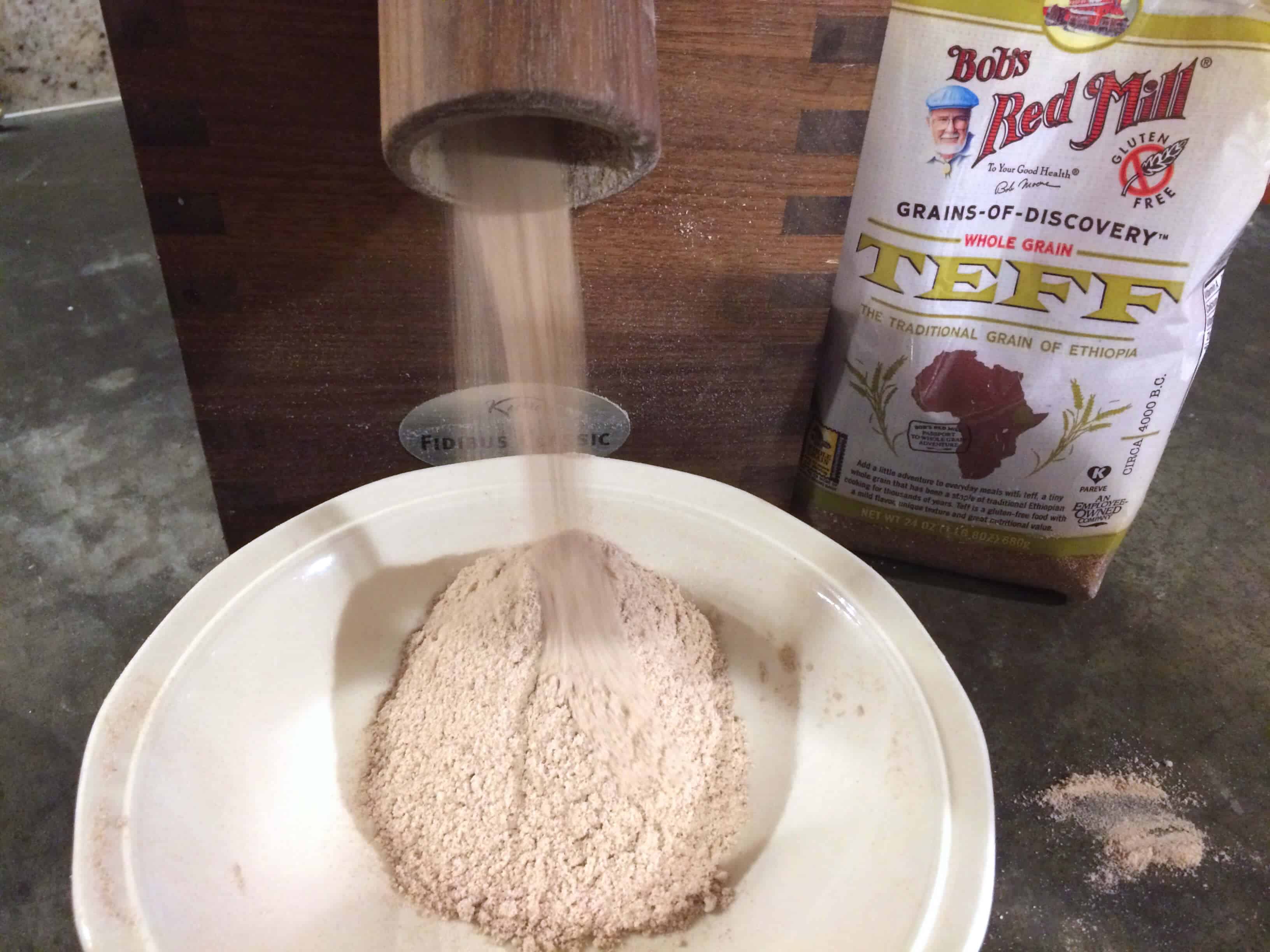
Whether you’re grinding your own flour or using pre-ground, you’ll need 2 cups of flour. I’m using all teff flour, and mine happens to be dark teff flour which will produce a very dark injera with a deeper flavor.
As mentioned above, using 100% teff flour is traditionally considered the most desirable (it also happens to be naturally gluten-free), but you can substitute part of it with other flours such as wheat or barley.
However, if you’re new to making injera I recommend substituting a portion of teff with barley or wheat flour as 100% is more challenging to work with.
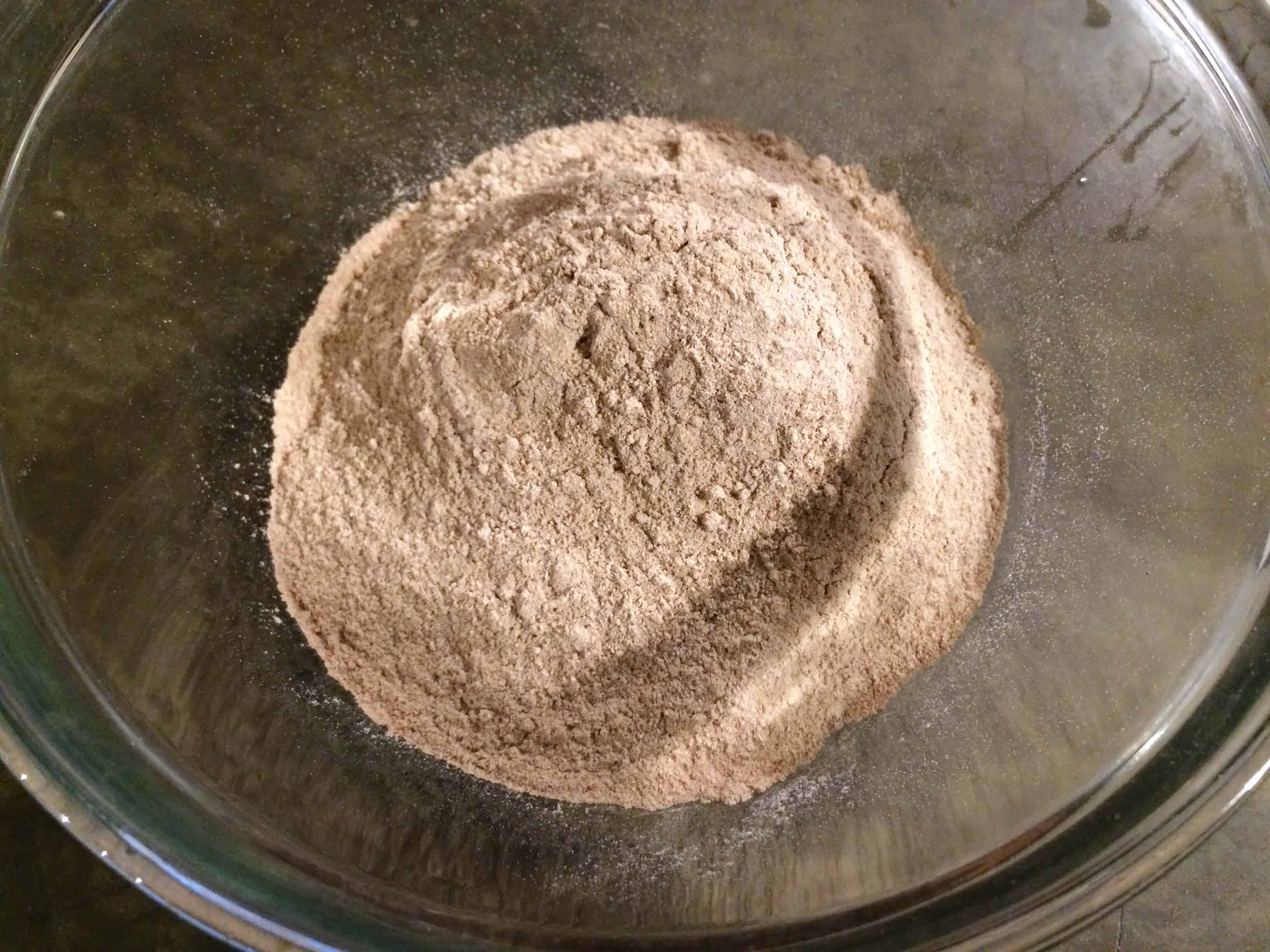
Stir in 3 cups of distilled water (and the yeast if you’re using it).
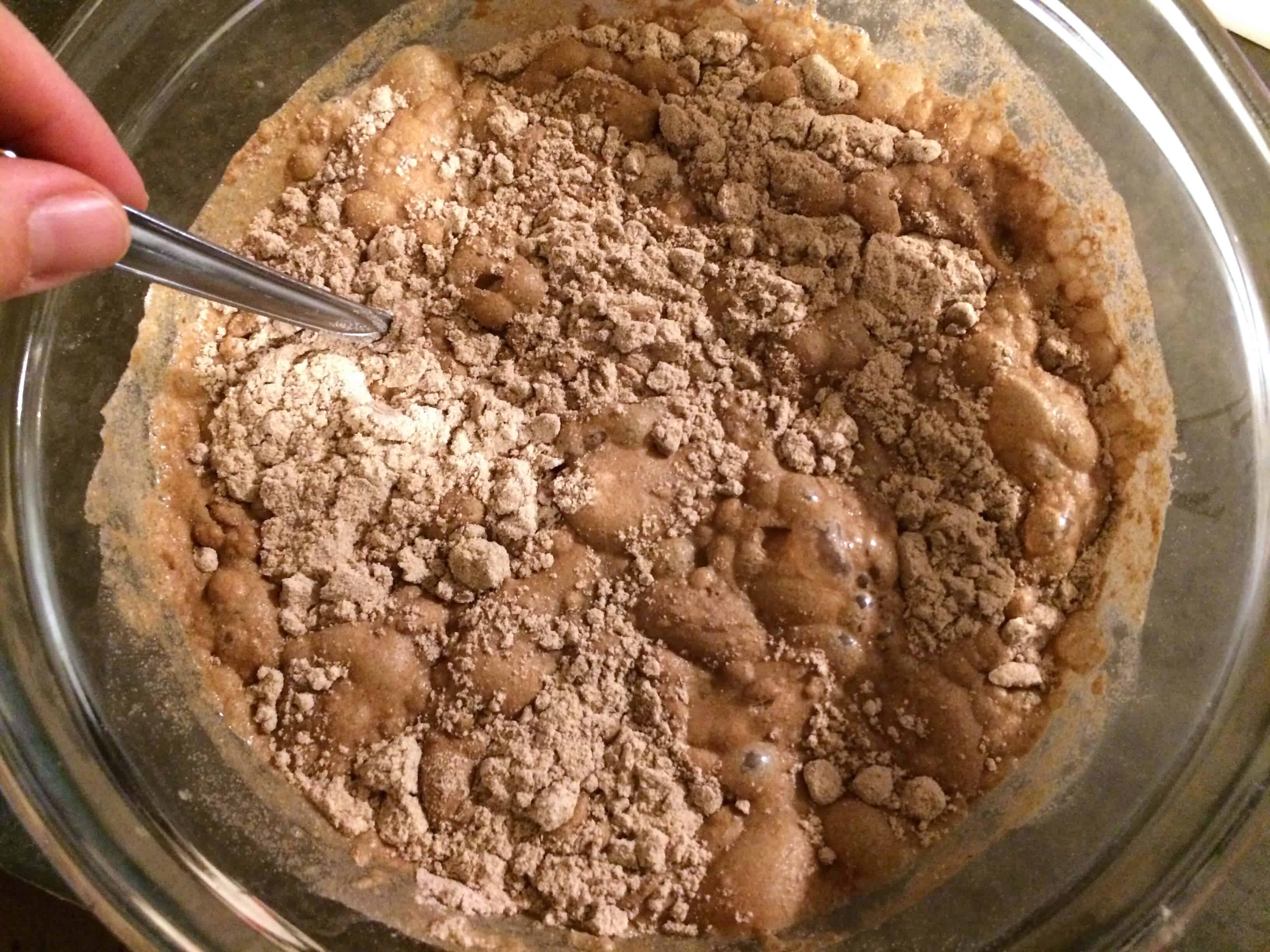
I made two versions to show you the difference – both are identical but in one of them I added some commercial yeast (left) and the other one I didn’t (right). What that does is prevent the formation of wild yeast because the commercial, store-bought yeast dominates.
Loosely cover the bowls with plastic wrap so that air can still get in (but no critters can) – cheesecloth is also a great option. Let it sit undisturbed at room temperature for 5 days. You don’t have to let it ferment that long but at least 4 days is ideal and longer it ferments the deeper the flavor will be.
Note: Depending on what kind of flour you’re using, you may need to add a little more water if the mixture is becoming dry.
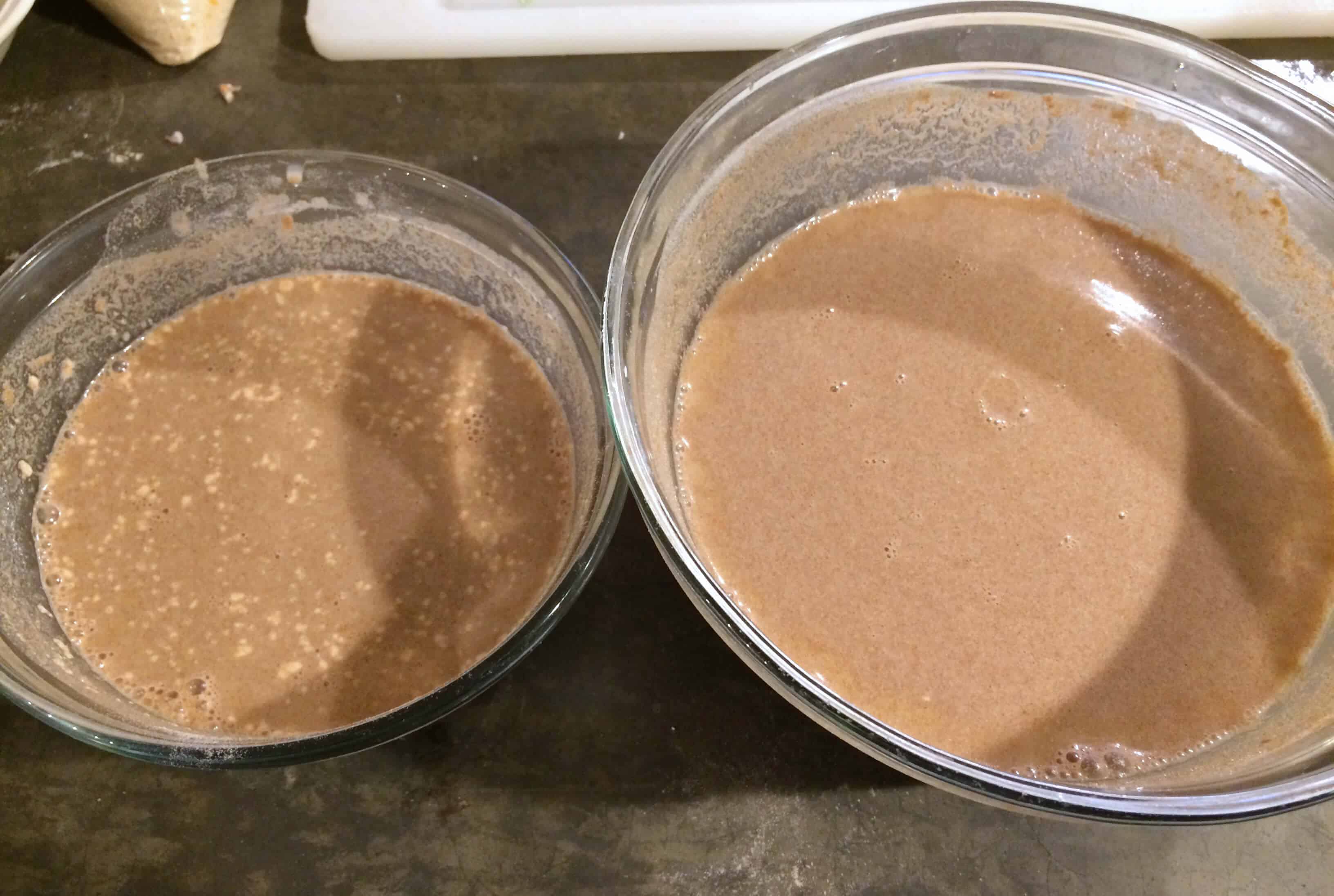
After 4-5 days both versions will be fizzy when you jiggle the bowl.
Notice the difference between the mixture prepared with commercial yeast (left) and the wild yeast mixture (right). The version made the traditional way allowing wild yeast to form is not only much darker in color, it has a film of aerobic yeast on top that you may initially think is mold but it isn’t. If your batter forms actual mold on it it will need to be discarded.
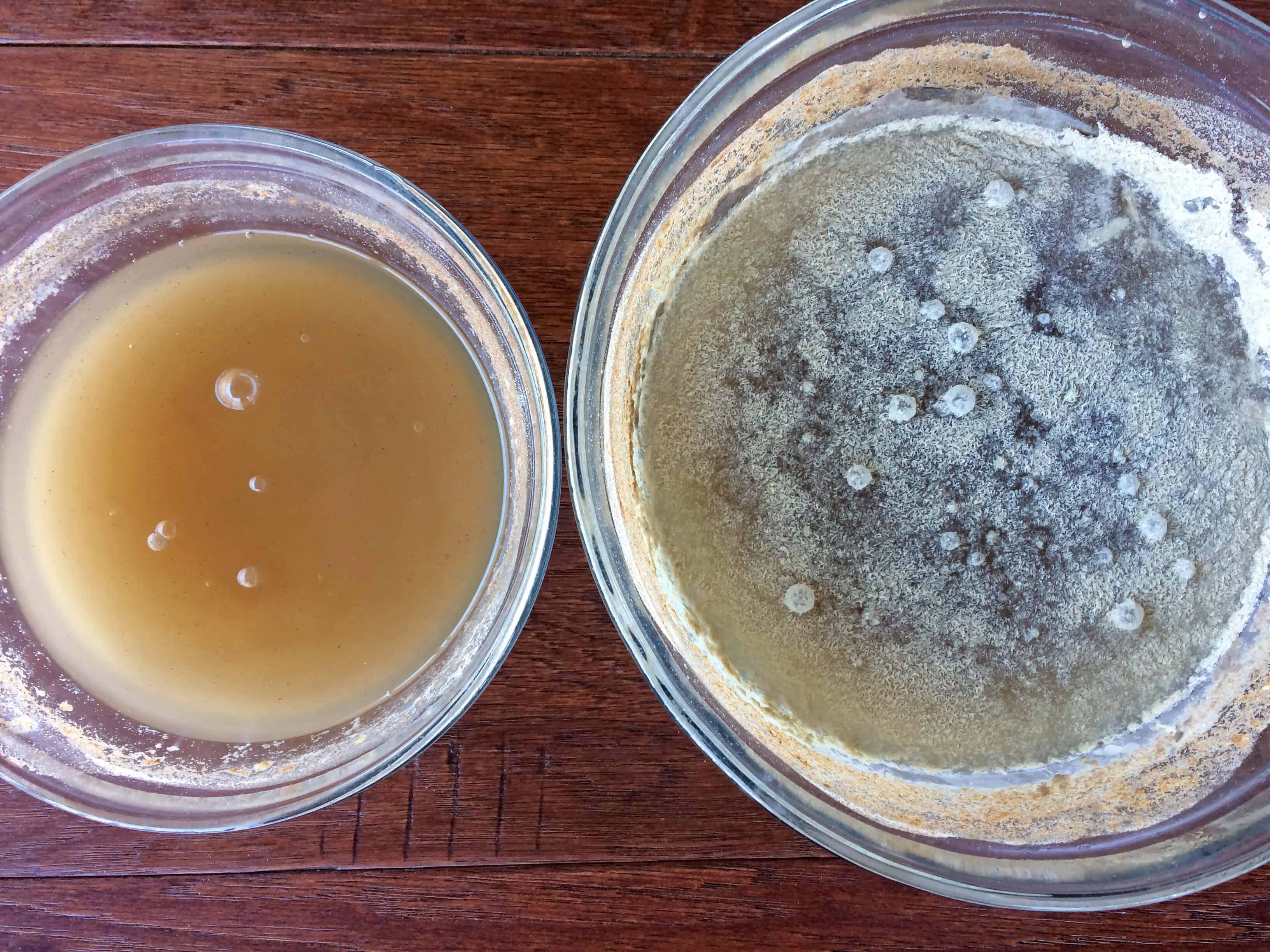
It looks disgusting, I know. Like why would I eat this? But rest assured it’s perfectly normal. That isn’t mold, it’s aerobic yeast caused by the fermentation process. Going the traditional route of relying on wild yeast – a naturally fermented product – over commercial yeast results in an injera with a richer and more complex flavor. It’s the way injera has been made and enjoyed for centuries. Again though, if your batter forms actual mold on it, it will need to be discarded.
We’re simply going to discard this top layer and use what’s underneath. So pour off the top layer and as much of the liquid as you can.
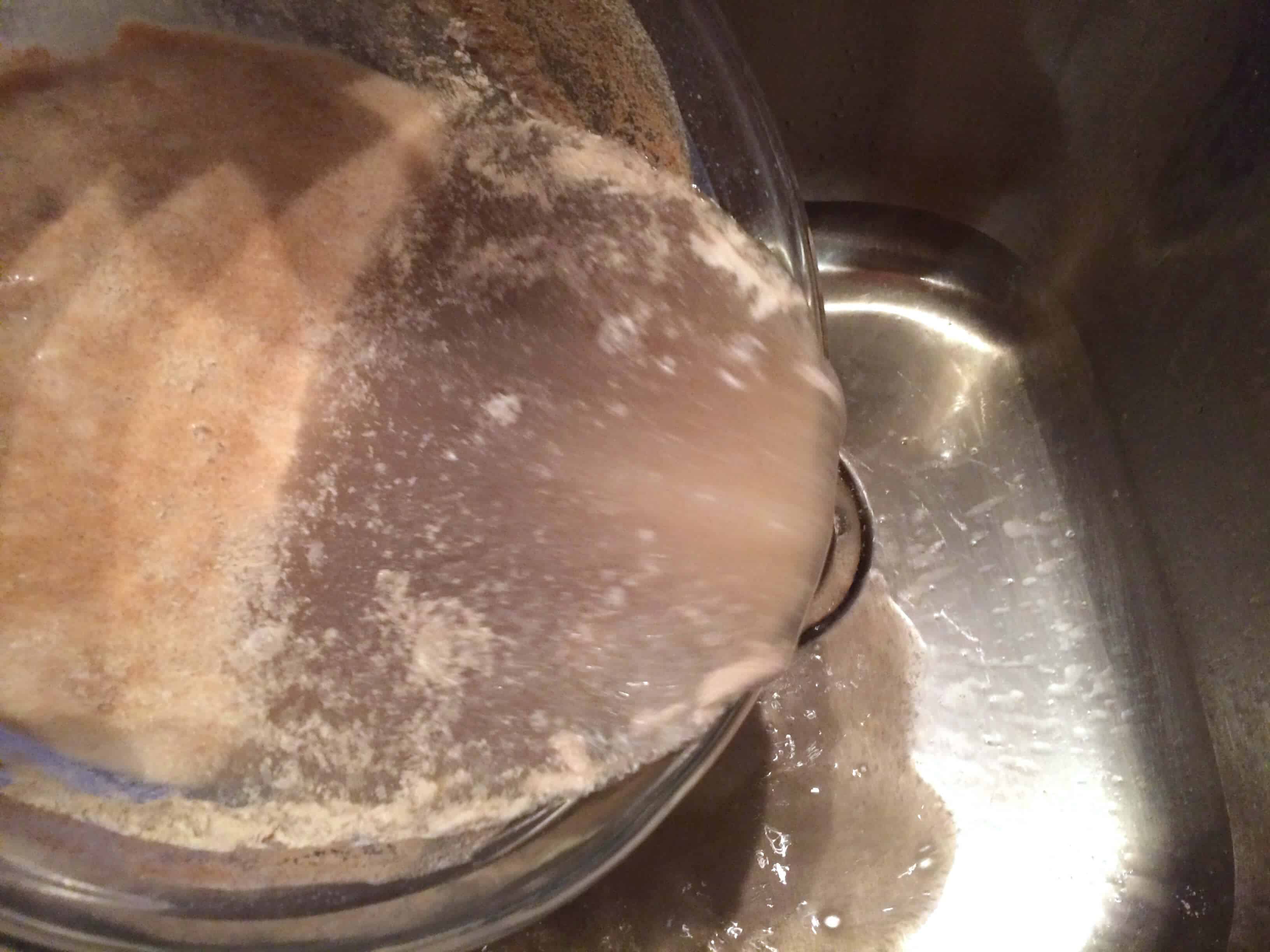
You’ll be left with a clay-like batter. Give it a good stir.
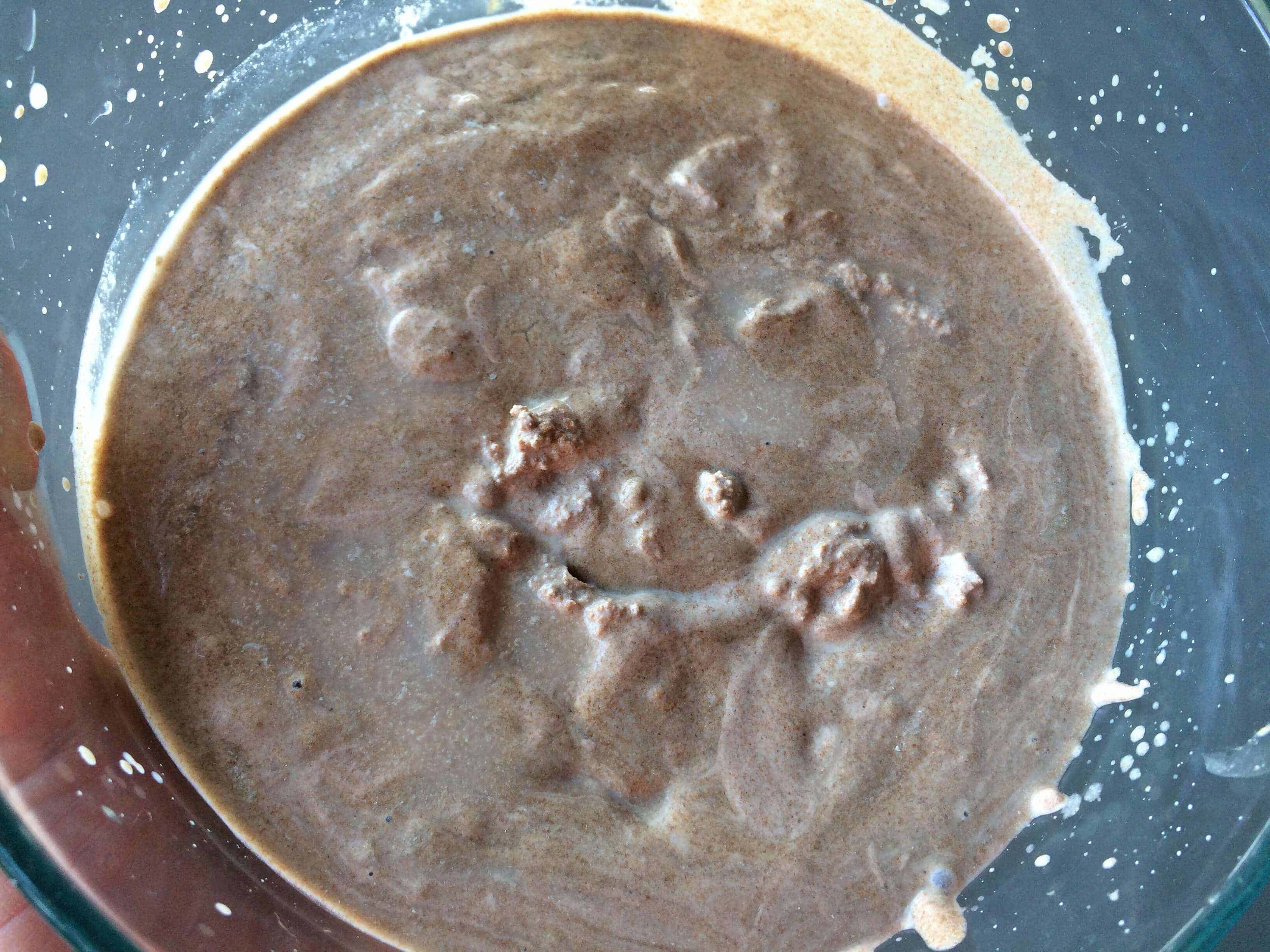
Bring 1 cup of water to a boil in a small saucepan. Scoop 1/2 cup of the fermented teff batter and stir it into the boiling water until the mixture is thickened. This will happen pretty quickly.
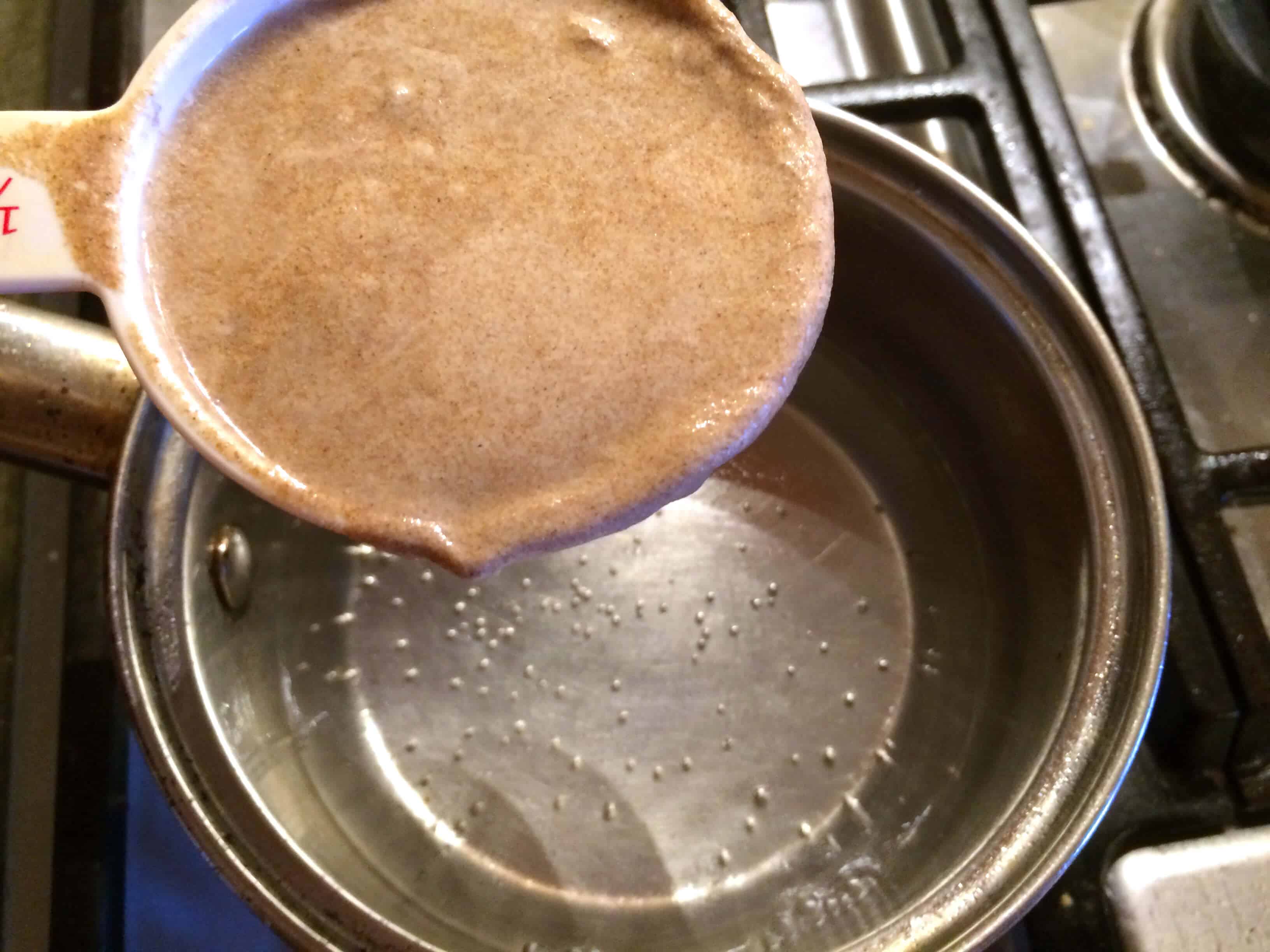
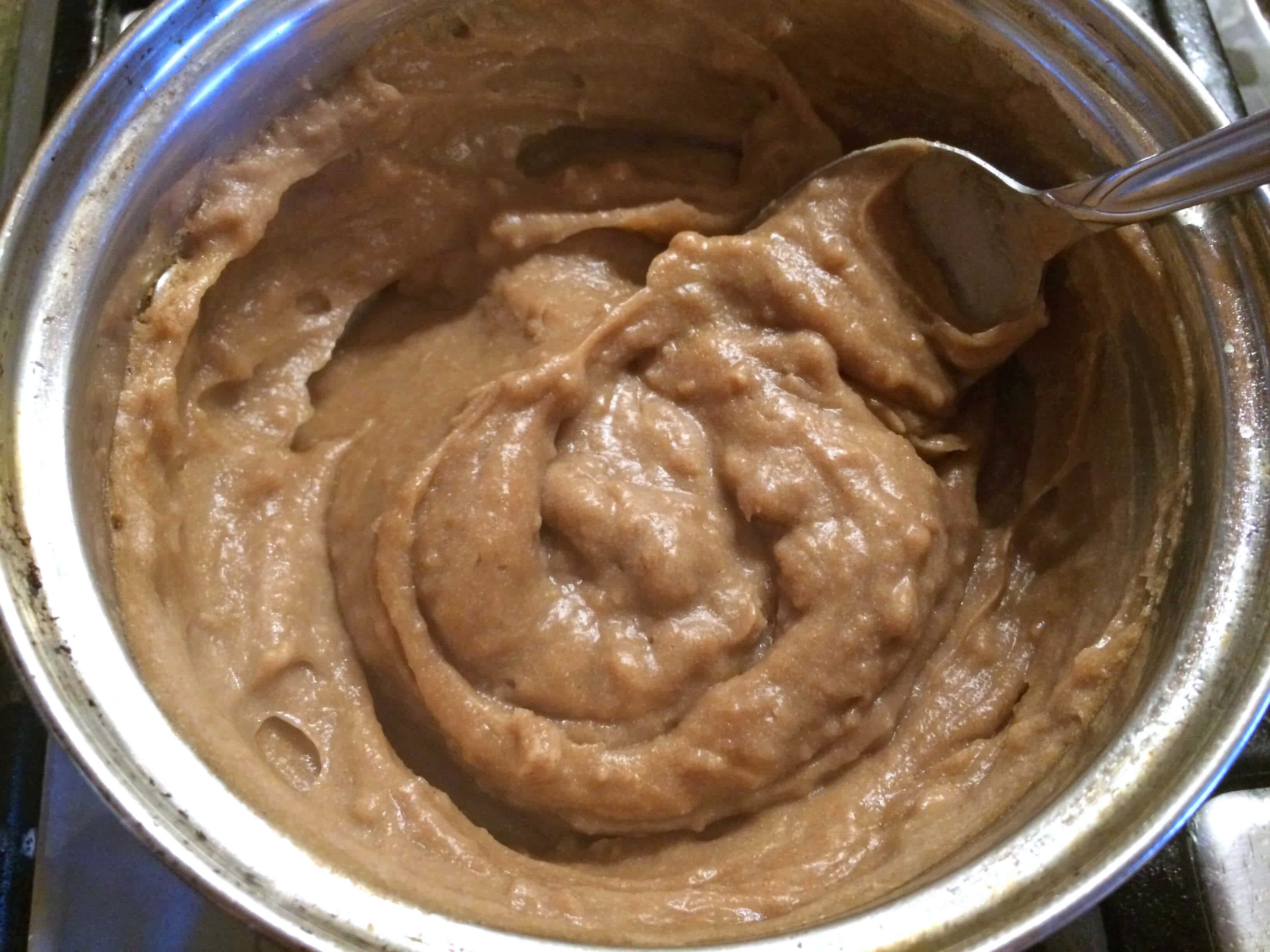
Stir the cooked/thickened batter back into the original mixture.
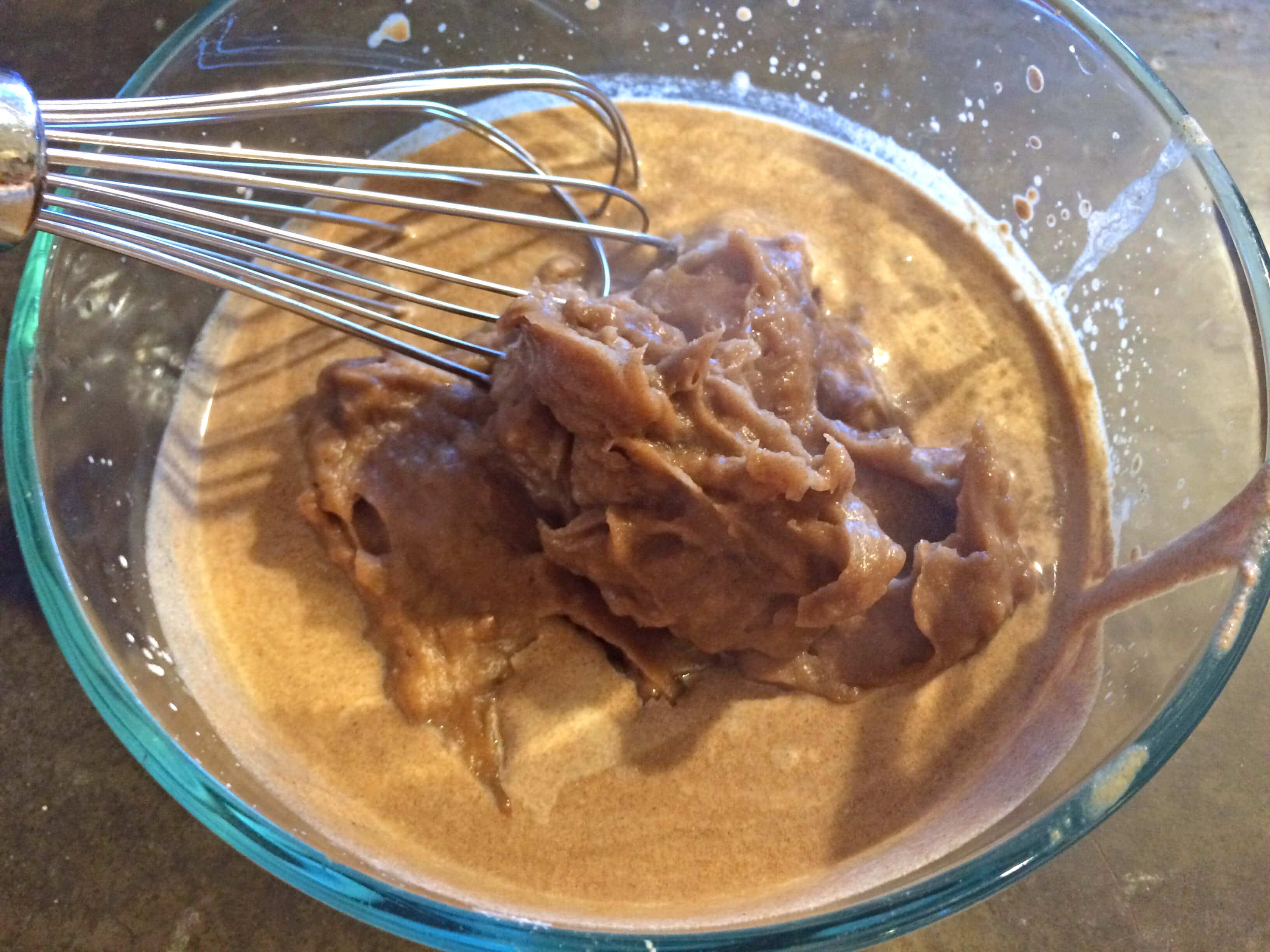
Add some water to the batter to create roughly the consistency of crepe batter. I added about 2/3 cup of water though this will vary from batch to batch. The batter will have a sweet-soured nutty smell.
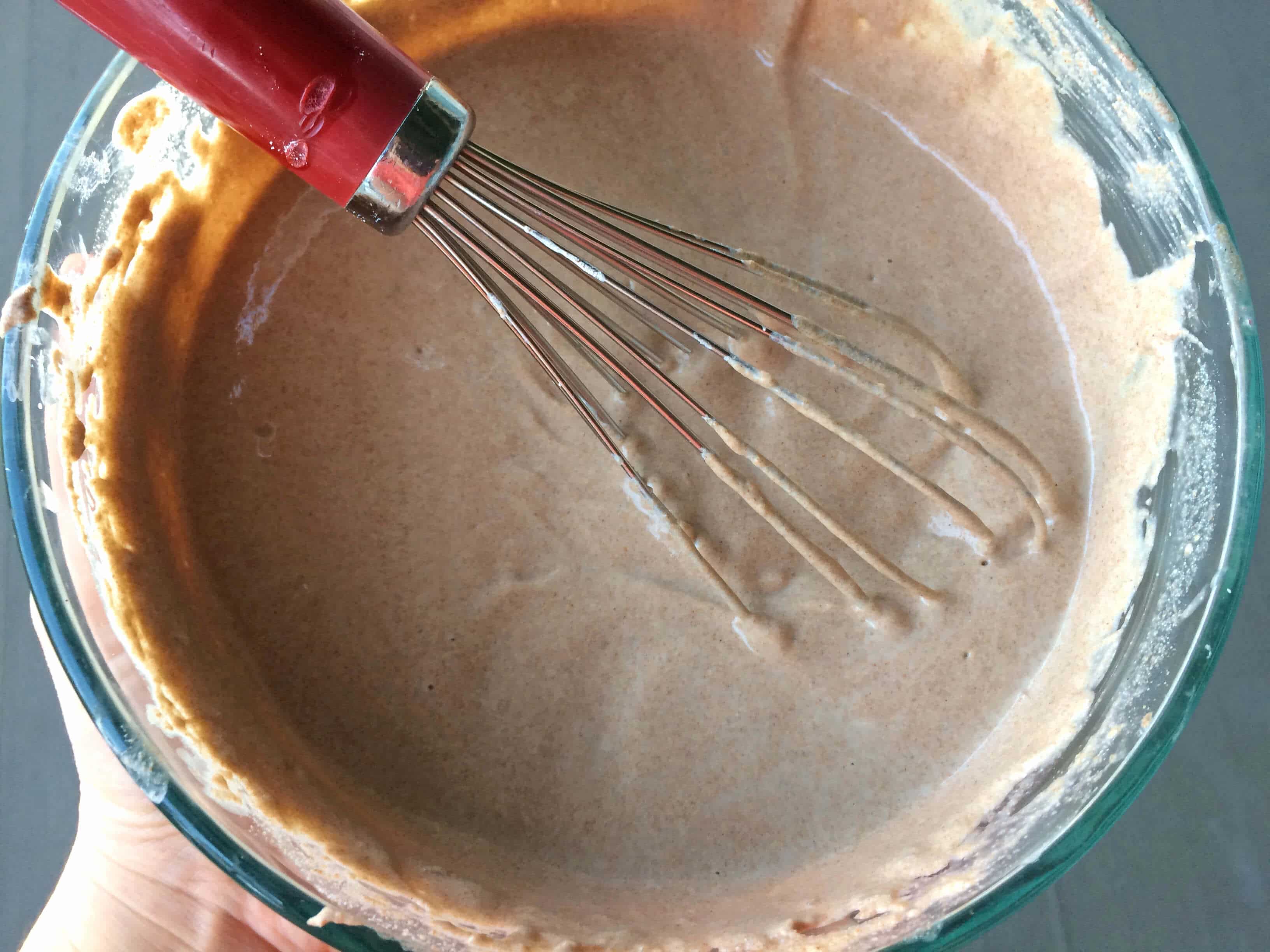
Heat a non-stick pan on medium. Depending on how good your non-stick surface is, you may need to very lightly spray it with some oil.
Coat the surface of the pan with a thin layer of injera batter. It should be thicker than making a crepe but not as thick as a pancake.
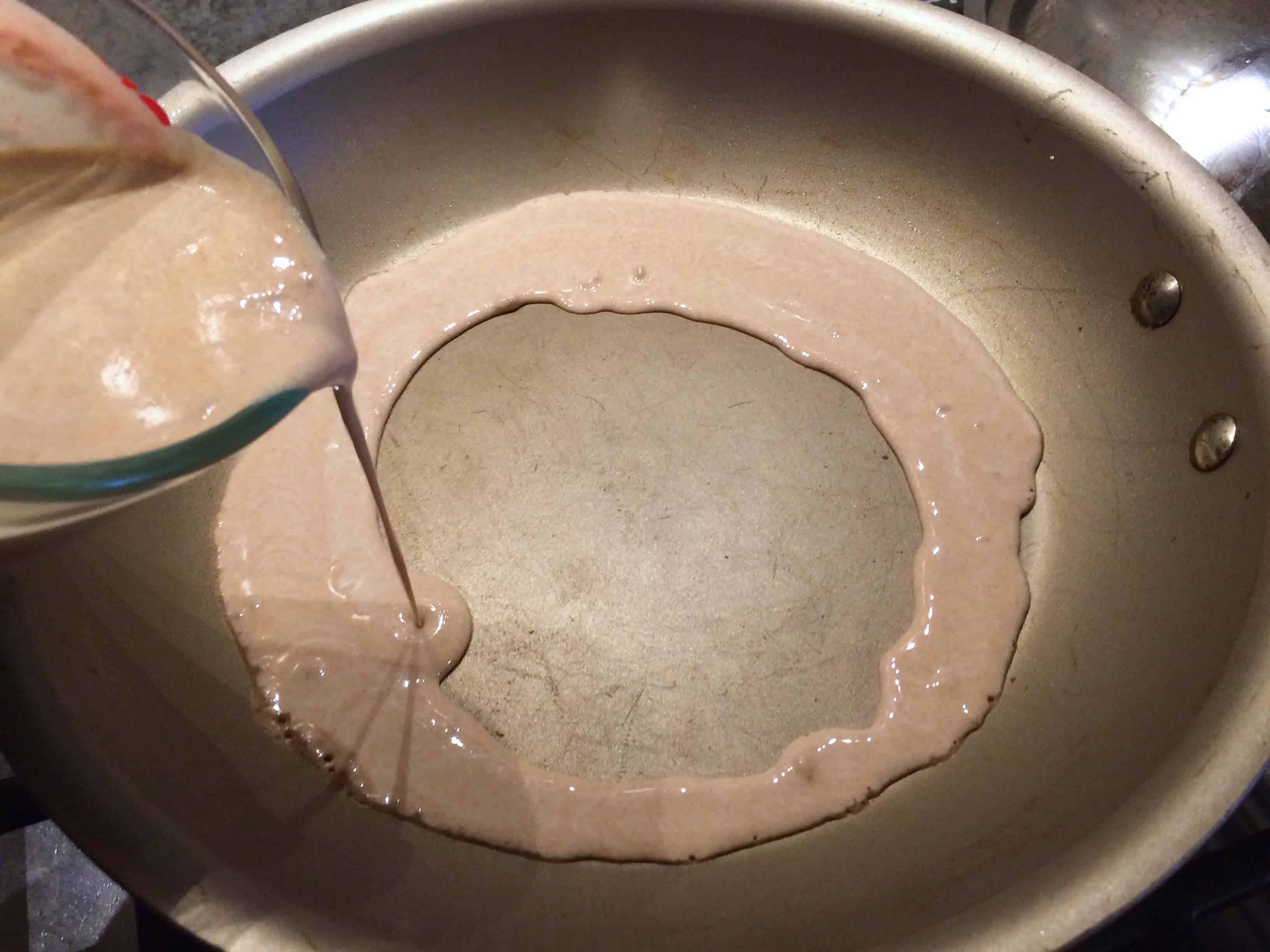
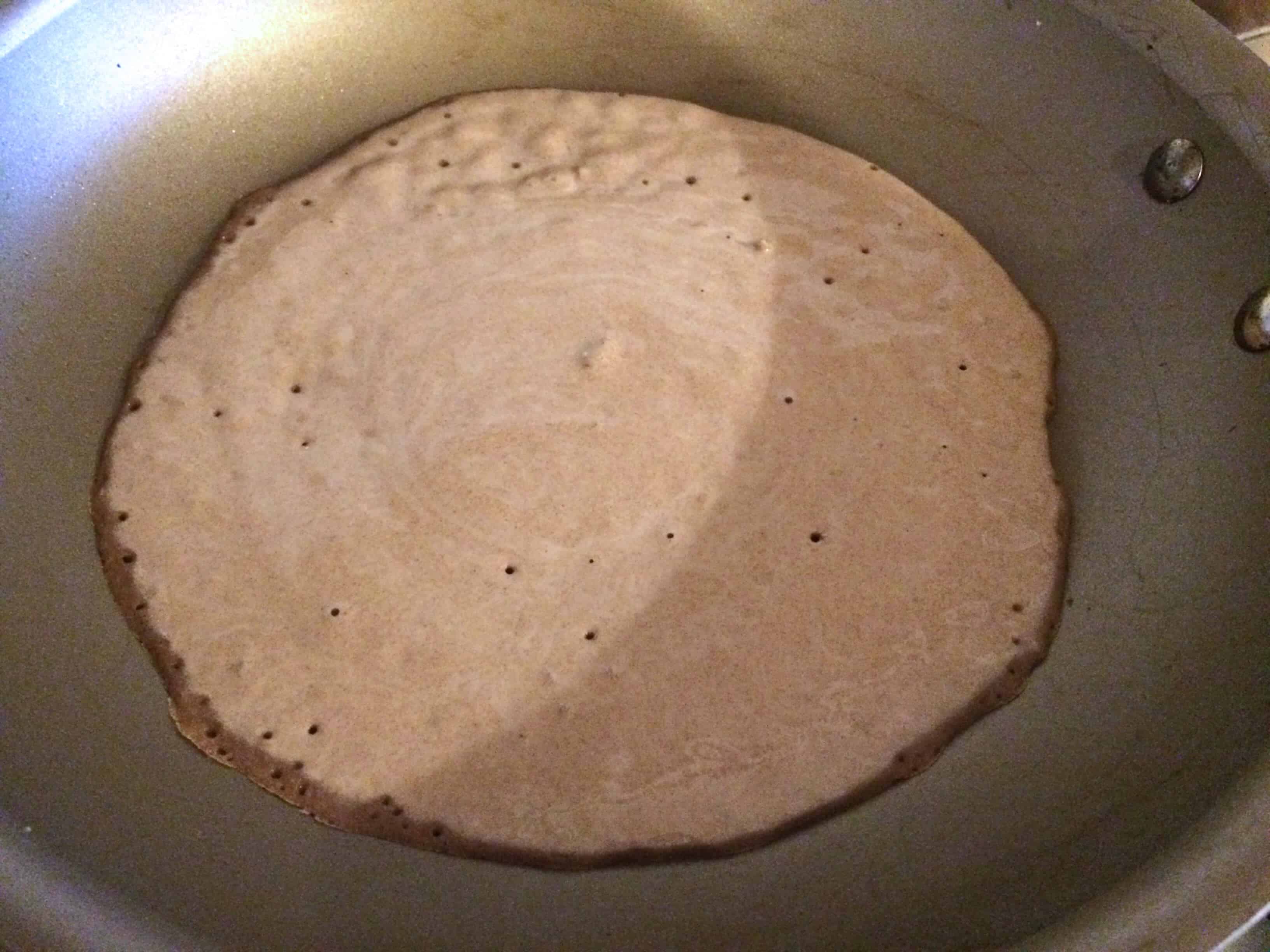
Continue to cook – bubbles will form, allow them to pop. Then cover the pan with a lid and turn off the heat to let it steam cook for a couple more minutes or so until cooked through. Be careful though, if you the injera cooks too long it will become gummy and soggy.
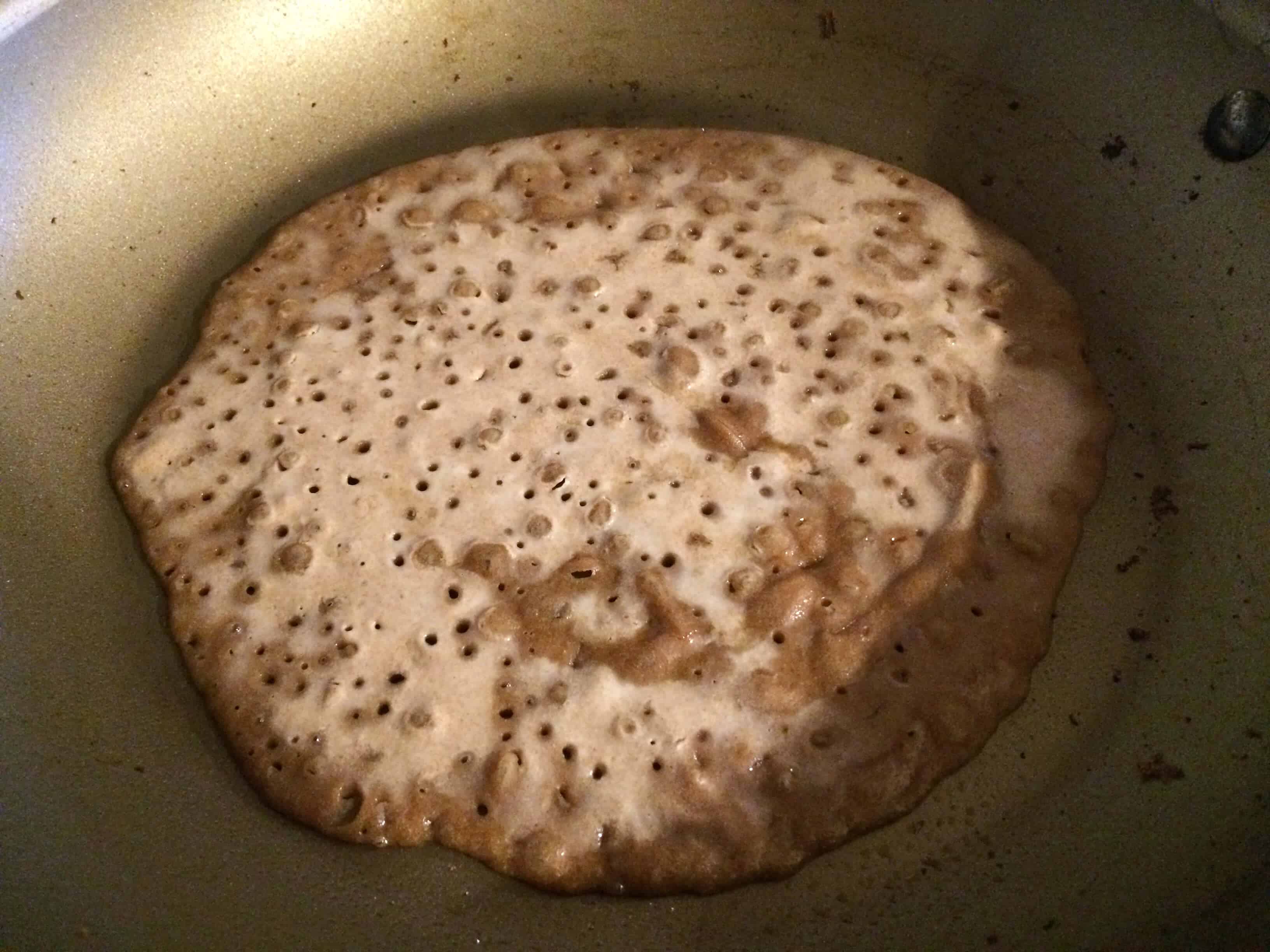
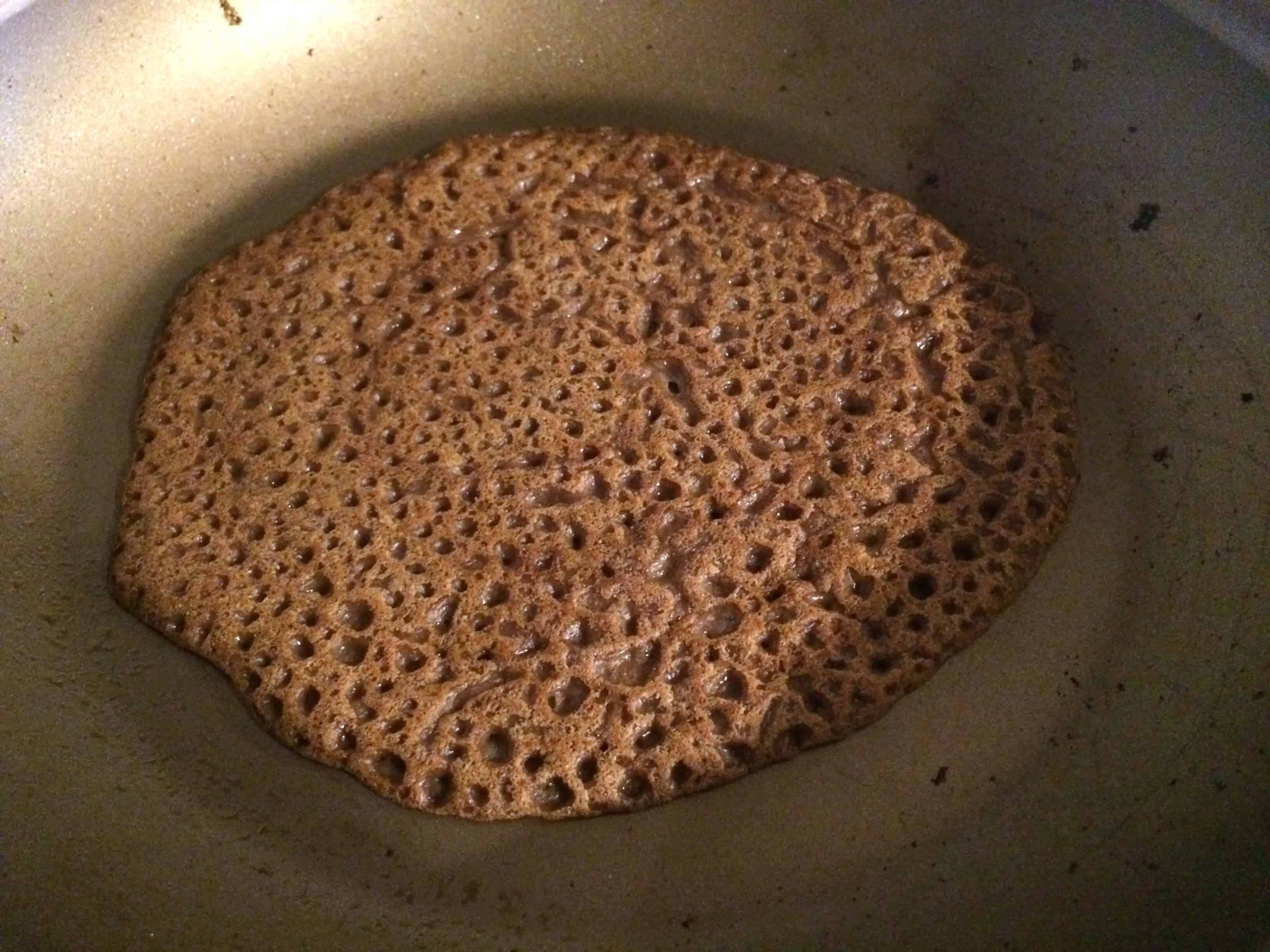
Remove the injera and repeat.
Serve your homemade injera with any of these authentic Ethiopian recipes: Doro Wat, Sega Wat, Misir Wat, and Gomen.
Enjoy!
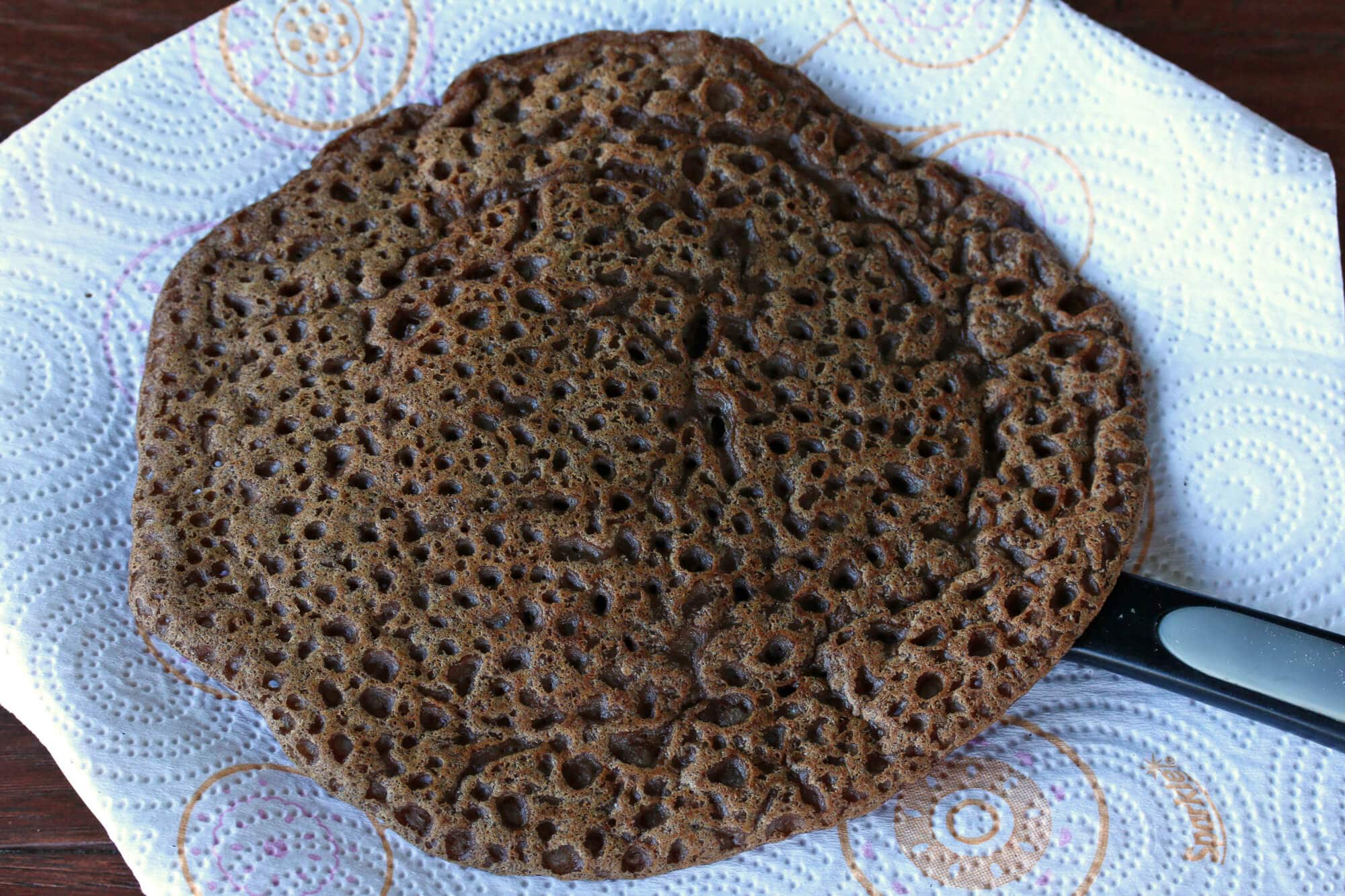
For more flatbread recipes from around the world to try my:
Save This Recipe
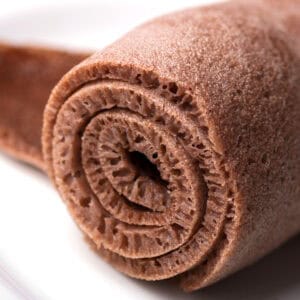
Authentic Injera (Ethiopian Flatbread)
Ingredients
- 2 cups teff flour, brown or ivory , or substitute a portion of it with some barley or wheat flour (note: teff is gluten free)
- Note: If you’re new to making injera I recommend using a combination of teff and barley or wheat as 100% teff is more challenging to work with.
- 3 cups distilled water (fluoride and chlorine will both interfere with the fermentation process)
- Note: This method involves wild yeast fermentation. See blog post for details about using commercial yeast as a starter (you’ll use about 1/4 teaspoon dry active yeast)
Instructions
- *See blog post for detailed instructions*NOTE: Using mostly or all teff (which is the traditional Ethiopian way) will NOT produce the spongy, fluffy injera served in most restaurants which are adapted to the western palate and use mostly wheat, sometimes a little barley, and occasionally a little teff added in.
- In a large mixing bowl, combine the flour and water (and yeast if you're using it). Loosely place some plastic wrap on the bowl (it needs some air circulation, you just want to keep any critters out) and let the mixture sit undisturbed at room temperature for 4-5 days (the longer it ferments, the deeper the flavor). (Depending on what kind of flour you're using, you may need to add a little more water if the mixture is becoming dry.) The mixture will be fizzy, the color will be very dark and, depending on the humidity, a layer of aerobic yeast will have formed on the top. (Aerobic yeast is a normal result of fermentation. If however your batter forms mold on it, it will need to be discarded.) Pour off the aerobic yeast and as much of the liquid as possible. A clay-like batter will remain. Give it a good stir.
- In a small saucepan, bring 1 cup of water to a boil. Stir in 1/2 cup of the injera batter, whisking constantly until it is thickened. This will happen pretty quickly. Then stir the cooked/thickened batter back into the original fermented batter. Add some water to the batter to thin it out to the consistency of crepe batter. I added about 2/3 cup water but this will vary from batch to batch. The batter will have a sweet-soured nutty smell.
- Heat a non-stick skillet over medium heat. Depending on how good your non-stick pan is, you may need to very lightly spray it with some oil. Spread the bottom of the skillet with the injera batter – not as thin as crepes but not as thick as traditional pancakes. Allow the injera to bubble and let the bubbles pop. Once the bubbles have popped, place a lid on top of the pan and turn off the heat. Let the injera steam cook for a couple or so more minutes until cooked through. Be careful not to overcook the injera or they will become gummy and soggy. Remove the injera with a spatula and repeat.
- IMPORTANT NOTE: Both the texture and color of the injera will vary greatly depending on what kind of teff you use (dark or ivory) and whether or not you’re combining it with other flours. Gluten-based flours (e.g. wheat and barley) will yield a much different texture than 100% teff. In the pictures and recipe below I’m using 100% dark teff, something you will not find in restaurants and will look different than what most are accustomed to, but is traditional to Ethiopian home cooking. Make your injera according to what you prefer.
Nutrition
Images of serving platter and woman cooking courtesy Maurice Chédel and Rob Waddington via CC licensing
Originally published on The Daring Gourmet February 7, 2017



















This deserves a 0/5 this looks nothing like Ethiopian injera. The audacity of the author to call this a recipe is so funny.
Sesen, this is not the injera that you’ll typically find in Ethiopia restaurants in Western countries. The injera pictured in the photos is made with 100% teff as it is traditionally made in Ethiopia.
Hello!
I tried this recipe for th first time and I think I made some mistakes.
1. I doubled the recipe. I was ambitious. However, I accidentally mixed all purpose flour with my teff flour at about a 50% ratio.
2. I let is sit for about 4 days, but it sat in a very wide mouthed jar. I did see that it bubbled a little over time, but nothing drastic.
3. After four days, it smelled… I guess sour would be the best word to describe it. I poured off the liquid, which didn’t seem to have mold or anaerobic bacteria. The liquid smelled a bit like alcohol.. alcoholish.
4. I thickened it with hot water, but twice the batter and twice the water… Then proceeded to cook it in a pan after combining it with the original batter.
The Results.
1. My injera tastes rather… plain. It does not taste sour like injera I have had in restuarants.
2. The texture is a bit odd. It looks almost raw on the inside, despite the cooking team. It breaks easily, unlike the soft injera I have had.
I would love any tips! I’m anxious to make this asap!
Hi Kimberly! thanks for this recipe. I have now tried it twice though my injera always comes out very moist without the dry fluffy texture. What am I doing wrong here? I’ve put it on the burner for about 3 to 4 minutes until the bubbles pop and then cover it for another 3 to 4 minutes and then put it on a plate and let it cool but it’s not dry by the time that it’s cool it’s still wet inside. Do I need to cook it longer or do something different?
Hi Phil, if it’s wet inside then yes, it needs to cook longer. Teff injera will not produce the fluffy texture that we’re accustomed to in “westernized” Ethiopian restaurants. If that’s the texture you’re after you’ll want to use regular wheat flour.
Thanks for the recipe. I’ve made injera before so I think I can help with the issues people are experiencing.
Too strong/sour: add a bit more white flour to the mix before cooking to dilute the flavor. Add more water to the batter until the right texture is achieved.
Too gooey: your batter is too wet. Add more flour to it and try again. Also, method is key: pour the batter into the pan and then leave it uncovered until almost completely dry on top (you should see lots of eyes). Then cover. Whenever condensation accumulates on the lid, remove it with a towel then replace the lid. The injera is done when the edges start to curl up.
Crispy/dry: you’re cooking at too high of a heat
No eyes: your batter might be under or over fermented. If it’s not sour, it hasn’t fermented long enough. Leave for another day or so. If it’s very sour it might be over fermented. Add more flour to it and wait until it goes bubbly again. If you want to cook it that day, add a tablespoon of cornstarch and baking powder as a quick fix.
Also for the many people who have asked about a sour dough starter recipe. Here’s one I’ve used in the past:
945g water
160g Teff
230g flour
250g sourdough starter
Leave to ferment over night and cook the next day.
I hope this helps!
I had a terrible time cooking my injara once I did the Preparatory steps. Every single one stuck so badly I had to wash the pan in between , regardless of heat of the pan or amount of oil I did or did not use. Bubbles had all popped and dough appeared ‘set’, however, every single one in the whole batch refused to let go of my multi-layer stainless steel frying pan and seemed gummy and undercooked. Do I need one of those fancy new ecological non-stick pans? I know I am impatient and perhaps did not let it cook long enough for fear of it becoming gummy as you mentioned . Appreciate any advice on the cooking phase before I start fermenting another batch. Thank you so much and for your response to my previous question!
Hi Diana, yes it will stick like crazy in a stainless steel pan. You don’t need anything fancy, just a standard non-stick pan. Alternatively a cast iron pan that is REALLY well seasoned so that it has become non-stick.
So excited to find your authentic all teff Ethiopian injera recipe as I love teff and cannot tolerate any Wheat! I got sick just as the batter was fermented for 5 days so put it in the refrigerator. Would you recommend I bring it back to room temperature before proceeding with cooking? Also, I know I do not have the energy to cook the entire batch today so I’m wondering if I should leave it covered on the counter or return the unused portion to the refrigerator with the cheesecloth cover and repeat the room temperature warm up process when I cook more? Thank you so much for your lovely detailed instructions, I’m definitely looking forward to getting to eat what I believe will be my first all teff injera!
Hi Diana, I’d take out however much you’re going to use and let it come to room temp before cooking and leave the rest of the batch in the fridge. If you leave the rest of it at room temp it will continue to ferment and the flavor will be overpowering. Happy cooking!
What other dish we need to eat JingeraHow much gycimic Intex it will have for a pan cake
Hello! In the instructions, you recommend beginners substitute a part of the teff flour with wheat flour. Do you suggest half teff and half wheat flour? Or 3/4 teff, 1/4 wheat flour? Thank you!
Hi Sarah, I would recommend at least half wheat flour, or 3/4 wheat and 1/4 teff.
I made it with brown teff the natural fermentation way and on day 5 it looked sprouted and stunk in a most unpleasant way. It definitely did not appear clay like. Where did I go wrong?
Nevermind, I just cooked it further and it’s delicious. I had undercooked it. It still didn’t bubble, so maybe it’s just a thickness thing?
I blended teff grain with water in a Blendtec and let it sit for 3 days – it was furiously bubbly. However now that I’m cooking (after the gelatinizing step) – it’s cracked and didn’t yield the bubbles. I also barely had any water to drain off during that step. The flavor is okay – quite fermented, but not in the same way as I remember gluten free restaurant injera to be. Any idea where I went wrong? Thank you!
How do you tell the difference between mold and aerobic yeast.. will it be absolutely obvious?
Hi Jeaneliz, there is a ton of information on fermentation online and I would recommend looking up some pictures and YouTube videos to get a few visuals of the difference.
Question on timing of steps…
Did you do the draining of the aerobic yeasts, cooking a portion of itabd adding it back in with more water after the fermentation phase? Right before cooking? Or is that part in the middle of the fermenting phase?
Hi Flick, that takes place in Step 3, after fermentation (Step 2).
Thanks, I’m going to cook a batch today.
This looks exactly like sour dough started. Ugly as all get out, but sweet smelling and not bitter. I have made my father’s cowboy sour dough my entire life. He was born on a ranch in southern Oregon, in a valley in the coast range. Cowboy sour dough is slightly tangy, but much less so than commercial or than San Francisco sour dough.
In terms of yeast – would the fermentation time be different if using fast rising yeast?
Yum! This will be a great project. Fir anyone is Canada Berman Teff is a family owned business which sells both brown and white teff, whole and ground